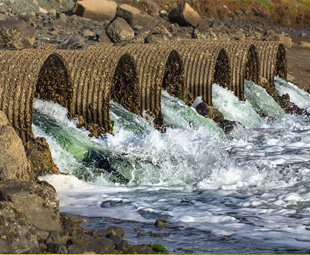An end to Cape Town’s water woes?

Civil engineer and University of Cape Town PhD researcher, John Okedi, is studying ways in which storm water falling over Cape Town can be used to offset the current water shortage.
Cape Town uses about 300-million cubic metres of water annually, most of which comes from the six major reservoirs. However, four times as much as that falls on the city as rain each year.
Unfortunately, most of the water goes unused in times of water scarcity. Most of the storm water is managed through a network of ponds and channels that divert it into rivers and the sea. This system of managing storm water leads to higher flows of poor-quality water downstream.
The challenge is to effectively store this water. One way to do so, according to Okedi, is to exploit some of the approximately 800 retention ponds in Cape Town that are usually empty until required for flood management.
“There is already quite a substantial network of ponds in the city,” he says. “It is possible to use some of the 60 ponds in the Lotus River catchment for longer-term storage while still being available, through pre-emptive discharge prior to major storms, to control flooding.”
A second way is to make use of the Cape Flats Aquifer (CFA). Much of the Cape Flats is made up of beach sand, in some places in a layer up to 50-m thick. A mere three metres of this in the region of the Lotus River is theoretically sufficient to store up to 100-million cubic metres of water.
Okedi and others have been looking into the possibility of managed aquifer recharge (MAR). This is the artificial management of the levels of water in the aquifer by encouraging infiltration in selected spots, which makes water available for later extraction via boreholes. An added attraction of this approach is that MAR offers an element of water treatment. According to Okedi, the method is already being implemented in other parts of the world, such as the Netherlands and Denmark, as well as locally on a smaller scale in Atlantis, north of Cape Town.
“We know it works,” he says. “In Atlantis, storm water is infiltrated into the local aquifer through two large ponds, to be abstracted as required by a system of boreholes. This has ensured a steady supply of water for some 40 years.
“In the case of the CFA, the catchment has been subjected to considerable impacts from land use as diverse as solid-waste disposal sites, informal settlements and agricultural practices. What we don’t know is the long-term impact in terms of the various pollutants as well as the feasibility of using the system at this scale. However, if we can get it right, this could potentially relieve the city of the need to supply 33-million kilolitres of potable water per year – which is more than ten percent of the current average supply using MAR in the Lotus River catchment.”
Unfortunately, building the infrastructure for such a system would take several years.
Designed



